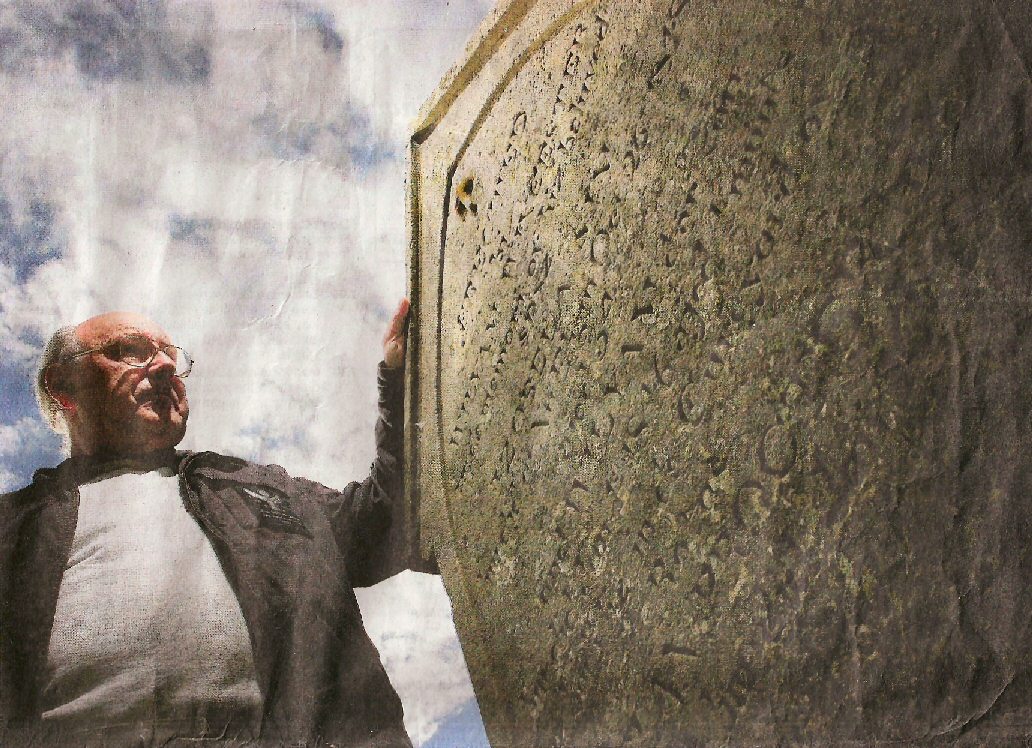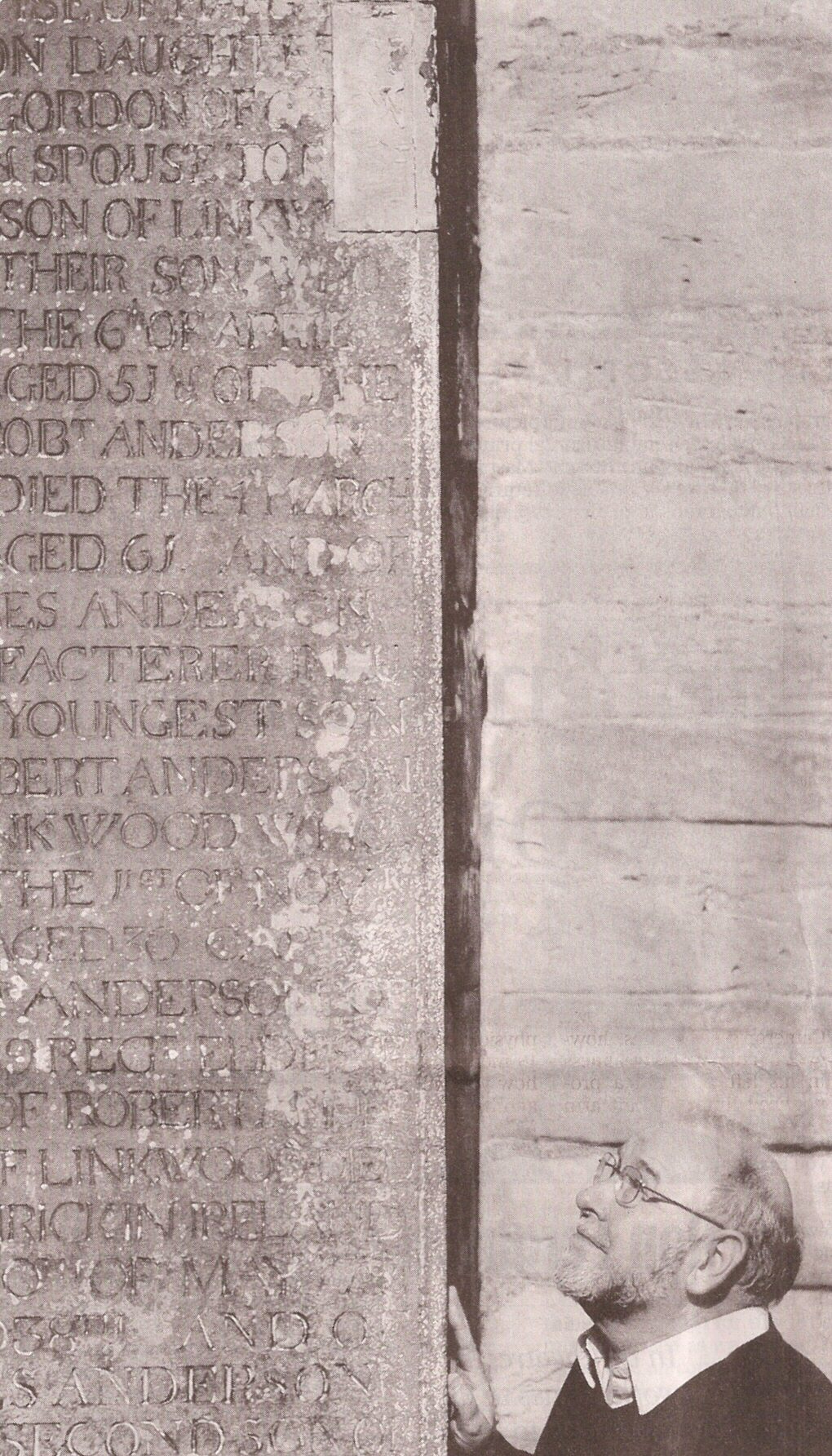|
Birnie Churchyard, near Elgin, Moray - Tombstone 241 |
|
|
|
|
|
ERECTED bi WILYAM WINCESTER tw de memori ov hiz beluved spδz IZOBELA SIM hw did at Nu Elgin Oct 26 1848 ajed 34 and WILYAM dar sun hw did Jan 1st 1846 ajed 4 munts hiz bodi liz in de Curcyard ov Rotas olso ELAN PROCTER hiz wifs mudr hw did Jan 16 1849 ajed 67 Σe iz licwiz berid at Rotas |
|
|
This translates in modern terminology as: Erected by William Winchester to the memory of his beloved spouse Isobella Sim who died at New Elgin Oct 26 1848 aged 34 and William their son who died Jan 1st 1846 aged 4 months, his body lies in the Churchyard of Rothes. Also Helen Proctor his wife’s mother who died Jan 16 1849 aged 67. She is likewise buried at Rothes. |
|
|
Elgin Cathedral, Moray - Tombstone 617 |
|
|
This is the burial place of THOMAS ANDERSON in Barmuckatie who died the 4 of May 1674. (&?) of ROBERT ANDERSON (C)ommissar Cleark (sic) of MURRAY (sic) his son who died the 17 of October 1715. & of IANET HEPBURN his spouse who died the 10 of March 1692 & of IAMES ANDERSON of Linkwood, Provost of Elgin who died the 28 of August 1731 aged 51 & of BARBRA KING his spouse who died the 18 of July 1744 aged 56 & of WILLIAM ANDERSON of Linkwood, Provost of Elgin who died the 13 of June 1745 aged 38. Their son likewise of MARGARET (G)ORDON daughter of (A)LEXR. GORDON of Ca(irnfi)eld & spouse to R(O)BT. ANDERSON of Linkwood. Also their son, who died the 6th of April 1773 aged 51. & of the said ROBT. ANDERSON who died the 4th March 1777 aged 61. And of CHARLES ANDERSON, Manufacterer (sic) in Huntly, youngest son of ROBERT ANDERSON of Linkwood who died the 1rst of Novr. 1790 aged 30. Capt. ALEXR. ANDERSON of the 69 Regt. eldest son of ROBERT ANDERSON of Linkwood, died at Limrick (sic) in Ireland the 30TH of May 1791 aged 38TH (sic). And of JAMES ANDERSON Esqr. second son of ROBERT ANDERSON of Linkwood who died at Edinr. the 20 May 1808 aged 51 and of CLEMENTINA GORDON daughter of MR. GORDON in Newseat, spouse of the said CHARLES ANDERSON who died 25th Octr. 1813 aged 52. CHARLES ANDERSON their son and HARRIET ROUTH his spouse, who both died and were buried in Aberdeen. |
|
|
Press Release: |
|
|
Press and Journal, Moray Edition,
25th September 2007 |
|
|
|
|
|
Moray gravestone epitaphs make their
mark |
|
|
INSCRIPTIONS PICKED OUT IN
COMPETITION AS AMONG THE MOST UNUSUAL IN BRITAIN |
|
|
|
|
|
SET IN STONE: Bruce Bishop with the Anderson
memorial. (Photograph: Ed Jones) |
|
|
Two gravestone epitaphs in Moray have been pinpointed as among the most
unusual in Britain following a national search. The first stands 16ft in the grounds of Elgin Cathedral and marks the place where the wealthy Anderson family were laid to rest. The second can be found in Birnie Churchyard, near Elgin, where William Winchester marked the deaths of his wife, son and mother-in-law, with an inscription written entirely in shorthand. The two epitaphs were among hundreds of entries from across Britain to be submitted into a competition by BBC History Magazine in its search for the most bizarre, enigmatic or surprising gravestone inscriptions. They were entered by the Moray Burial Ground Research Group, which is conducting a project to record every burial ground and tombstone in Moray. Already, more than 3,000 tombstones have been recorded. When we saw this competition advertised we went back through the archive and picked these two out to be the most interesting," said group secretary Bruce Bishop. "We never expected them to be picked out as two of the most unusual. Outside Moray I have seen other ones just as weird or different." He said the Anderson tombstone was considered remarkable because of its sheer size and the amount of information it lists, recording family deaths over a 139-year period from 1674 to 1813. It is attached to the south wall of the cathedral and is the original burial place of Thomas Anderson, of Barmuckity, who died on May 4, 1674. Thereafter, the epitaph lists the deaths of a string of family members. Mr Bishop said he believed the inscriptions were amalgamated on to one tombstone after the cathedral graveyard was tidied up during the 19th century. He said there were likely to have been many original stones belonging to members of the Anderson family, which had since vanished. The second unusual memorial dates back to 1848 when William Winchester buried his wife Isobella. "As far as we know this is the only stone engraved totally in the Pitman phonetic alphabet, there are just bits and pieces on others in Scotland," said Mr Bishop. The most bizarre epitaph in Britain belongs to a 19th-century woman from Loughborough, Leicestershire, whose short and painful life is described in great detail. Suffering from liver disease, Sarah Johnson's inscription details the 28 times she was drained of fluid in her abdomen, with full details of the doctors who did the work. The competition was launched to increase understanding of the importance of gravestone inscriptions. |
|
|
|
|



